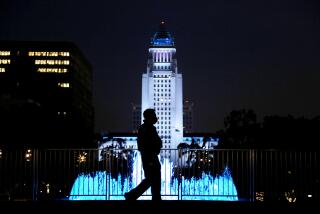Valley Secession Proposal Too Flawed for Ballot, L.A. Says
- Share via
With a crucial decision on San Fernando Valley secession a week away, Los Angeles city leaders Tuesday mounted a last-ditch attack on the breakup proposal, saying it should not be placed on the November ballot without major revisions.
The City Council voted unanimously to recommend that a state commission not schedule a secession election until Los Angeles’ concerns about the proposal’s financial impact are addressed. The council claims that the plan would create a multimillion-dollar hole in the city’s budget.
By California law, a secession measure can be put to a citywide vote only if the Local Agency Formation Commission finds the breakup “revenue neutral,” or financially fair to both the Valley and the remainder of the city.
LAFCO is scheduled to vote May 22 on whether to call a secession election. Its staff has determined that an independent Valley would be financially healthy, and that a breakup would not harm the remainder of the city.
But Los Angeles officials have repeatedly challenged LAFCO’s math. On Tuesday, the council adopted a consultant’s report showing that secession would cost the city at least $153 million a year in lost revenue, money that a Valley city would have to pay Los Angeles in so-called alimony.
That estimate is almost three times the $55.8 million in payments proposed by LAFCO. But it is much lower than the nearly $300 million that city officials had previously demanded.
The council’s action also means the city will not agree to transfer assets in the Valley, such as fire and police stations, without compensation, because it does not believe it has been made financially whole. LAFCO, which is also reviewing secession proposals for Hollywood and the harbor area, has said it can require asset transfers even if the city objects.
“The bottom line for the city of Los Angeles could be catastrophic if this is not recognized,” said Ed Hamilton of the consulting firm Hamilton, Rabinovitz & Alschuler Inc., hired by the city to analyze likely costs again.
Hamilton’s estimates were based on a review of just eight of the more than 40 city departments. It examined “stranded” costs for centralized services that Los Angeles says it would still carry if the Valley broke away.
Secessionists called the city’s objections fodder for a possible lawsuit aimed at keeping Valley cityhood off the ballot.
Richard Close, head of the secession group Valley VOTE, noted that LAFCO has rejected the stranded costs argument. Los Angeles could cut its costs if it no longer has to serve the Valley, he said.
“The city is coming up with as much as it can to build a legal case to challenge a vote on cityhood or to scare residents of the city into believing the city will go broke,” Close said.
The council also approved a report by city Administrative Officer William Fujioka that says LAFCO failed to properly study the viability of Valley cityhood, and did not fully consider the negative fiscal impact of secession on the remainder of Los Angeles.
The Fujioka report is scheduled to be considered by LAFCO today. It raises 20 objections to the cityhood study, all of which address financial issues that LAFCO has been wrestling with for two years.
City services in Los Angeles after secession would have to be cut by about $303 million over the next 27 years, the report says. It contends that LAFCO inaccurately divided bond debt between Los Angeles and a Valley city.
In addition, Fujioka told the council, the proposed $18-million reserve fund for the Valley is “woefully inadequate.”
City officials also said LAFCO erred in not including a $4-million annual deficit at Van Nuys Airport in the commission’s fiscal study.
Assistant City Atty. Fred Merkin raised legal objections to the LAFCO study, saying it does not meet the requirement for a thorough examination of the potential financial harm to Los Angeles.
Merkin and the council also maintained that LAFCO does not have authority to force Los Angeles to charge residents of a Valley city the same water and power rates assessed in Los Angeles.
*
Times staff writer Nita Lelyveld contributed to this report.
More to Read
Sign up for Essential California
The most important California stories and recommendations in your inbox every morning.
You may occasionally receive promotional content from the Los Angeles Times.














